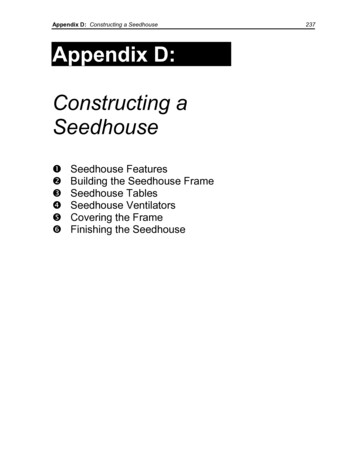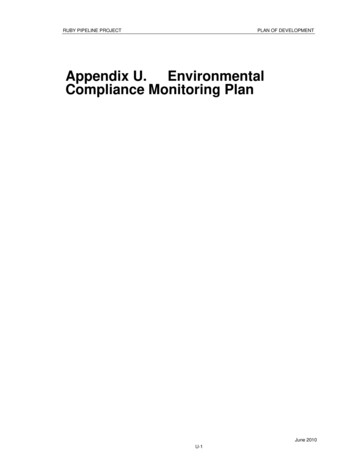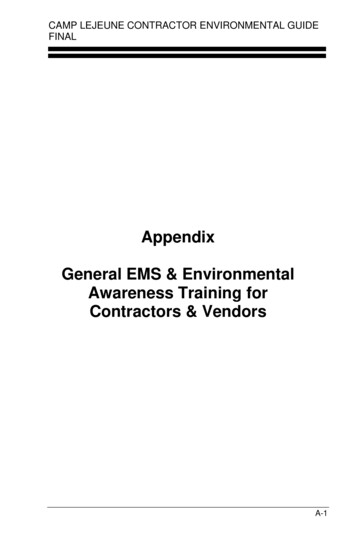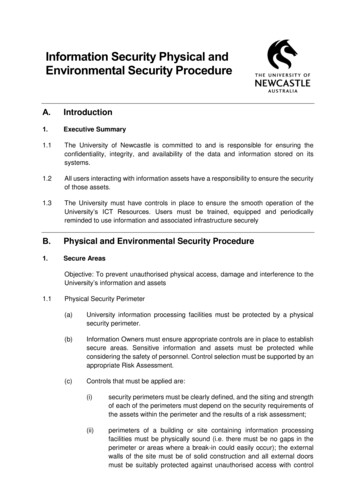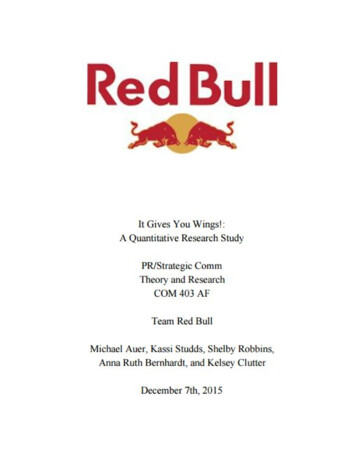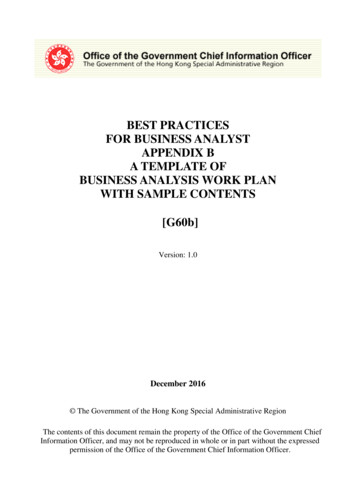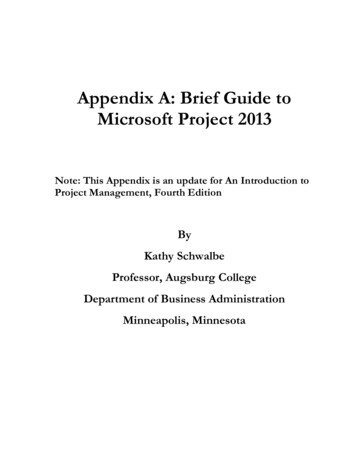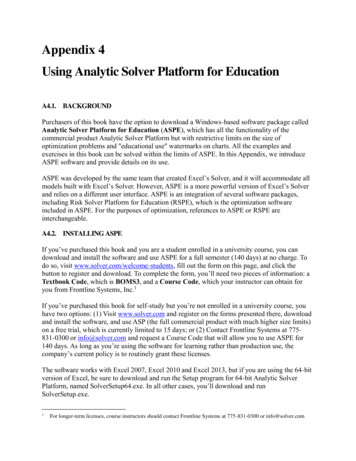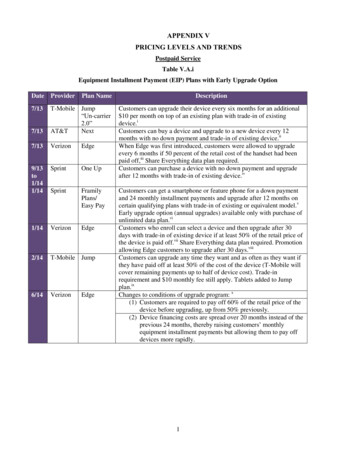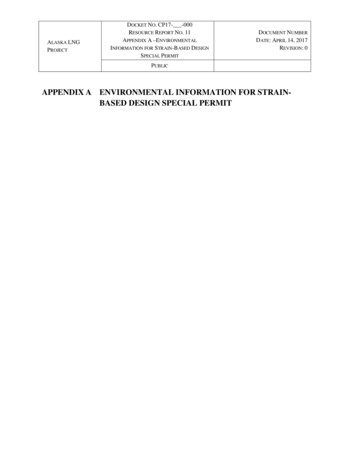
Transcription
ALASKA LNGPROJECTDOCKET NO. CP17- -000RESOURCE REPORT NO. 11APPENDIX A –ENVIRONMENTALINFORMATION FOR STRAIN-BASED DESIGNSPECIAL PERMITDOCUMENT NUMBERDATE: APRIL 14, 2017REVISION: 0PUBLICAPPENDIX A ENVIRONMENTAL INFORMATION FOR STRAINBASED DESIGN SPECIAL PERMIT
Appendix AEnvironmental Information for Strain Based Design Special PermitThe purpose of this enclosure is to augment the National Environmental Policy Act analysis presented inthe Alaska LNG Project Federal Energy Regulatory Commission Resource Reports (FERC RR) withinformation that meets specific U.S. Department of Transportation, Pipeline and Hazardous MaterialsSafety Administration (PHMSA) requirements for a special permit as described in 49 Code of FederalRegulations (CFR) § 190.341. The Special Permit Conditions for usage of strain-based design and thisenclosure are also included together as Appendices A and B to the Alaska LNG FERC Resource Report11, Reliability and Safety.I.Purpose and NeedAlaska LNG is proposing to build a Mainline pipeline (the pipeline or the Mainline) to transportnatural gas to a proposed Liquefied Natural Gas (LNG) facility from a proposed gas treatmentplant located on Alaska’s North Slope. The Federal Energy Regulatory Commission (the FERC)is the lead Federal agency. The Federal Department of Transportation’s Pipeline and HazardousMaterials Safety Administration (PHMSA) has authority over the design and operation of naturalgas transmission pipelines under 49 CFR Part 192. 49 CFR Part 192 includes specific regulatoryrequirements for the design, construction, operation, and maintenance of natural gas pipelines tomaintain safety. If required, special permits can be granted under 49 CFR §190.341 for proposeddeviations from established pipeline standards. PHMSA imposes conditions on the grant ofspecial permits to assure safety and environmental protection in accordance with 49 CFR§ 190.341. PHMSA is required to comply with the National Environmental Policy Act (NEPA)in deciding whether to issue the special permit.Alaska LNG is seeking exemption from the requirements of 49 CFR § 192.103 in regions ofdiscontinuous permafrost. These regions will result in time dependent ground movement, whichwould require that that pipe be built with heavy walled pipe with sufficient thickness to withstandthe external forces of ground freezing and thawing, otherwise known as frost heave and thawsettlement, respectively. While pipelines transporting warm oil (e.g. Trans Alaska PipelineSystem: TAPS) can mitigate these forces through an aboveground pipeline, a high pressure gaspipeline built above ground would require prohibitively expensive steel metallurgy to ensurepipeline integrity commensurate to fulfill the requirements of 49 CFR § 192.53 at temperatures aslow as -50 F.Therefore, Alaska LNG intends to request a Special Permit from PHMSA to allow Strain-BasedDesign of this segment of the pipeline. Strain-Based Design (SBD) involves enhanced metallurgyand engineering to allow the pipe to deform in the longitudinal direction while maintaining itsintegrity and safety. SBD is a technology that enables compliance with 49 CFR § 192.53, whichrequires that materials are “able to maintain the structural integrity of the pipeline undertemperature and other environmental conditions that may be anticipated”.A Special Permit would allow Alaska LNG to design and construct the pipeline using StrainBased Design for discrete segments of the pipeline. The Special Permit would include conditions
Appendix AEnvironmental Information for Strain Based Design Special Permitto ensure the pipeline has equal or greater safety than a pipeline constructed in accordance with49 CFR Part 192.II.Background and Site DescriptionFigure 1 shows the proposed Mainline route from the proposed gas treatment plant located atPrudhoe Bay to the proposed LNG Plant site located on the Kenai Peninsula. The Mainlinewould be a 42-inch-diameter natural gas pipeline, approximately 807 miles in length, extendingfrom the Alaska LNG’s Gas Treatment Plant (GTP) on the North Slope to the LiquefactionFacility on the shore of Cook Inlet near Nikiski, including an offshore pipeline section crossingCook Inlet. The onshore pipeline would be a buried pipeline with the exception of short aboveground special design segments, such as aerial water crossings and aboveground fault crossings.As presented in Table 1.3.2-1 of FERC Resource Report 1, the Mainline would originate in theNorth Slope Borough, traverse the Yukon-Koyukuk Census Area, the Fairbanks North StarBorough, the Denali Borough, the Matanuska-Susitna Borough, and the Kenai PeninsulaBorough, and terminate at the Liquefaction Facility. The Mainline’s proposed design has amaximum allowable operating pressure (MAOP) of 2,075 psig.The Mainline would include several types of aboveground pipeline facilities. The proposeddesign includes eight compressor stations, four meter stations, multiple pig launching/receivingstations, multiple Mainline block valves (MLBV), and five potential gas interconnection points.A list of compressor stations, heater station, and meter stations is provided in Table 1.3.2-6 ofFERC Resource Report 1.Approximately 36 percent of the Mainline route is collocated within 500 feet of an existing ROW,to include TAPS and other pipelines, highways or major roads, utilities and railroads. Table1.3.2-2 of FERC Resource Report 1 summarizes collocation of the Mainline route that are within500 feet of highways, major roads, the Trans-Alaska Pipeline System (TAPS), other pipelineROWs, utilities, and railroads. The Mainline crosses TAPS 12 times, the TAPS Fuel Gas Line 5times, and has four railroad crossings. Design of the road and railroad crossings would bevalidated for applicability of the minimum wall thickness requirements for service loads oncrossings in accordance with API RP 1102, using the appropriate design factor for the designclass location, and comply with 49 CFR § 192.111. The minimum depth of cover would be fourfeet for road crossings as specified by the Alaska Administrative Code 17.AAC 15.211“Underground Facilities” and 10 feet for railroad crossings, as specified in Alaska RailroadCorporation (ARRC) standards below travel surface (this exceeds the 49 CFR § 192.327(a)requirement which requires a minimum of three feet at drainage ditches of public roads andrailroads). Site-specific designs for major highway and railroad crossings will be provided inAppendix H of the FERC application. Additional details on roads, railroads, pipelines, utilities,and power lines crossings can be found in FERC Resource Report 8.
Appendix AEnvironmental Information for Strain Based Design Special PermitAerial crossings on pipeline specific bridges (i.e. bridges that carry only a pipeline) are located atNenana River at Moody and Lynx Creek. The design factor for the pipeline at aerial crossingswill comply with 49 CFR § 192.111.Pipeline design standards in 49 CFR § 192.5(a)(1) are based on “class location units,” whichclassify locations based on population density in the vicinity of an existing or proposed pipelinesystem. The lower the class location (1-4), the higher the design factor used to find the minimumrequired wall thickness for pressure containment, i.e. the required minimum thickness of the pipeincreases as the Class location. 99% of the Mainline route is in Class 1, which is defined ashaving 10 or fewer buildings intended for human occupancy located within 220 yards on eitherside of any continuous 1-mile length of pipeline. On the Kenai Peninsula, near Nikiski, there is aClass 2 location that is about 2.6 miles long. Also on the Kenai Peninsula there is a potentialClass 3 location as the Mainline nears the LNG Plant. In the Nenana Canyon region of DenaliNational Park ( MP 536) there is approximately a half a mile of Class 3. Additional details onclass locations for the Mainline can be found in FERC Resource Report 11, Section 11.7.There are 10 potential high consequence areas (HCA) along the Mainline as defined under 49CFR § 192.903. This includes two HCAs that are based on the aforementioned Class 3 locations.The remaining HCAs are located in Class 1 locations, details of which can be found in FERCResource Report 11, Section 11.7. In addition, the pipeline route segments that are addressed inthis Special Permit for Strain Based Design (the “Strain Based Design segments”) will beincorporated into the integrity management program (IMP), and treated as a covered segment in ahigh consequence area (HCA) in accordance with 49 CFR Part 192, Subpart O, and the SpecialPermit Conditions.The construction right of way (ROW) width will vary depending on the type of terrain, the seasonof construction, and the ease of access from nearby roads. The permanent ROW width would be50 feet plus the diameter of the pipeline, i.e. 53-1/2 feet. Greater details on construction ROWcan be found in FERC Resource Report 1. The Mainline would be sited on land composed ofmore than 85 percent federal, State of Alaska, and borough land of various holdings, with theremainder on privately owned land (see Resource Report 8).The proposed gas pipeline corridor spans five physiographic regions including the Arctic CoastalPlain, Arctic Foothills, Brooks Range, Yukon-Tanana Upland, and Tanana-Kuskokwim Lowland.These regions host a variety of ecosystems including muskeg bogs, spruce upland forest, alpineand Arctic tundra, high brush, and bottomland spruce and poplar forests. The associatedecosystems support a variety of species which include grizzly and black bears, arctic foxes, seals,caribou, moose, small terrestrial mammals, birds, and anadromous fish. A variety of marinemammals inhabit the coastal waters in the Project area, including the bowhead whale, polar bear,beluga whale, ringed seal, bearded seal, Stellar sea lion, harbor seal, ribbon seal and spotted seal.Some of these species are critical subsistence resources for Alaska Native peoples.
Appendix AEnvironmental Information for Strain Based Design Special PermitA detailed description of the Mainline ROW is included in Section 1.3.2.1 of FERC ResourceReport 1. Supporting facilities are described in Section 1.3.2.1.3 and temporary constructioninfrastructure is described in Section 1.3.2.4 of FERC Resource Report 1. Baseline environmentalconditions and the analysis of environmental effects resulting from construction and operation ofthe Mainline are addressed by individual resources as follows: Resource Report 2 (Water Use and Quality). Resource Report 3 (Fish, Wildlife and Vegetation). Resource Report 4 (Cultural Resources) Resource Report 5 (Socioeconomics) Resource Report 6 (Geological Resources) Resource Report 7 (Soils) Resource Report 8 (Land Use, Recreation and Aesthetics) Resource Report 9 (Air and Noise Quality)The pipeline will traverse areas potentially subject to geotechnical hazards (geohazards). Broadlydefined, a geohazard is a geological and/or environmental condition with the potential to causedistress or damage to civil works. Geohazards of particular interest for the Alaska LNG pipelineare time dependent, such as thaw settlement and frost heave. The geohazard from faultdisplacement, which is time independent, is not expected to be of concern for strain based designdue to the design/construction approach; that is, the active faults on the alignment will be crossedvia an aboveground mode designed to allow for fault displacement without exceeding the 0.5%axial strain criteria for strain based design.Thaw settlement may occur when ice-rich frozen ground temperature increases as a result of thedisturbance to the surface vegetative mat and/or an elevated temperature of the pipeline, causingground subsidence as the soil melts. The melting of previously permanently frozen (permafrost),ice-rich (i.e., contains ice in excess of the volume required to fill the pore space in an unfrozenstate) soils results in soil consolidation or settlement, the magnitude of which is dependent on thetype of soil and ice content. The settlement displacement divided by the initial thickness of thefrozen soil layer which is thawed is denoted as “thaw strain”.Frost heave occurs as a result of ice lens formation from freezing of the previously unfrozen soilbeneath the pipe. As the chilled pipe extracts heat from the unfrozen soil, a frost bulb developsaround the pipe. The interface between the unfrozen soil and the frost bulb is the frost front.Capillary action between the ice and water at the soil pore-scale causes water to be drawn to the
Appendix AEnvironmental Information for Strain Based Design Special Permitfrost front during the freezing process, forming discrete ice-lenses within the frost bulb around thepipe. The volumetric expansion of the soil within the frost bulb from the discrete ice lensescauses an upward displacement of the frost bulb and the pipe itself. Frost heave requires threesimultaneous conditions:1.availability of groundwater for ice lens formation at the frost front;2.an unfrozen "frost susceptible” soil; and3.a cold pipe (below 30ºF) capable of advancing the frost bulb beneath the soil.Frost susceptible soils are fine-grained silt and clay soils which freeze over a temperature rangebelow the freezing point of water (32 F) and as such develop water suction at the frost front.Granular sand and gravel soils are not frost heave susceptible because these soils develop onlyminimal suction at the frost front due to relatively large pore size. Natural soils that are alreadyfrozen are not considered frost susceptible for pipeline design because water migration in frozensoils is negligible. However, for purposes of evaluating heave potential, all soils in thediscontinuous zone are conservatively assumed to be unfrozen.Frost heave and thaw settlement are not intrinsic threats to pipe integrity. Pipe integrity concernsarise when the displacement from the soil movement is not uniform along the pipeline, such aswhen a heavi
crossings in accordance with API RP 1102, using the appropriate design factor for the design class location, and comply with 49 CFR § 192.111. The minimum depth of cover would be four feet for road crossings as specified by the Alaska Administrative Code 17.AAC 15.211 “Underground Facilities” and 10 feet for railroad crossings, as specified in Alaska Railroad Corporation (ARRC) standards .
